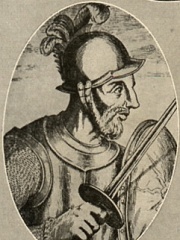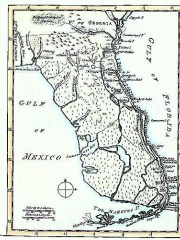
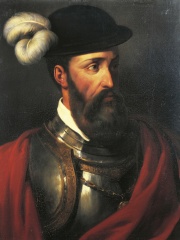
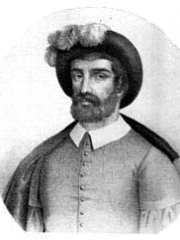
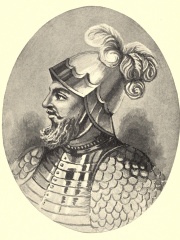
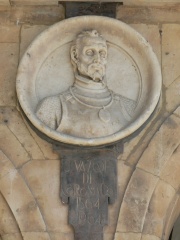
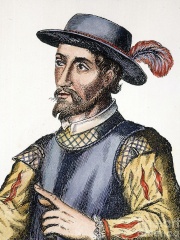
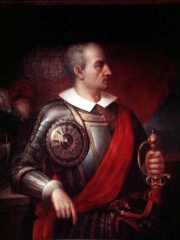
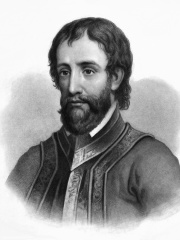
The Most Famous
EXPLORERS from Spain
Top 10
The following people are considered by Pantheon to be the top 10 most legendary Spanish Explorers of all time. This list of famous Spanish Explorers is sorted by HPI (Historical Popularity Index), a metric that aggregates information on a biography's online popularity. Visit the rankings page to view the entire list of Spanish Explorers.

1. Hernán Cortés (1485 - 1547)
With an HPI of 85.59, Hernán Cortés is the most famous Spanish Explorer. His biography has been translated into 145 different languages on wikipedia.
Hernán Cortés de Monroy y Pizarro Altamirano, 1st Marquis of the Valley of Oaxaca (December 1485 – 2 December 1547) was a Spanish conquistador who led an expedition that caused the fall of the Aztec Empire and brought large portions of what is now mainland Mexico under the rule of the King of Castile in the early 16th century. Cortés was part of the generation of Spanish explorers and conquistadors who began the first phase of the Spanish colonization of the Americas. Born in Medellín, Spain, to a family of lesser nobility, Cortés chose to pursue adventure and riches in the New World. He went to Hispaniola and later to Cuba, where he received an encomienda (the right to the labour of certain subjects). For a short time, he served as alcalde (magistrate) of the second Spanish town founded on the island. In 1519, he was elected captain of the third expedition to the mainland, which he partly funded. His enmity with the governor of Cuba, Diego Velázquez de Cuéllar, resulted in the recall of the expedition at the last moment, an order which Cortés ignored. Arriving on the continent, Cortés executed a successful strategy of allying with some indigenous people against others. He also used a native woman, Doña Marina, as an interpreter. She later gave birth to his first son. When the governor of Cuba sent emissaries to arrest Cortés, he fought them and won, using the extra troops as reinforcements. Cortés wrote letters directly to the king asking to be acknowledged for his successes instead of being punished for mutiny. After he overthrew the Aztec Empire, Cortés was awarded the title of marqués del Valle de Oaxaca, while the more prestigious title of viceroy was given to a high-ranking nobleman, Antonio de Mendoza. In 1541, Cortés returned to Spain, where he died six years later of natural causes.

2. Francisco Pizarro (1478 - 1541)
With an HPI of 82.05, Francisco Pizarro is the 2nd most famous Spanish Explorer. His biography has been translated into 87 different languages.
Francisco Pizarro (; Spanish: [fɾanˈθisko piˈθaro]; c. 16 March 1478 – 26 June 1541) was a Spanish conquistador, best known for his expeditions that led to the Spanish conquest of the Inca Empire. Born in Trujillo, Spain, to a poor family, Pizarro chose to pursue fortune and adventure in the New World. He went to the Gulf of Urabá and accompanied Vasco Núñez de Balboa in his crossing of the Isthmus of Panama, where they became the first Europeans to see the Pacific Ocean from the Americas. He served as mayor of the newly founded Panama City for a few years and undertook two failed expeditions to Peru. In 1529, Pizarro obtained permission from the Spanish crown to lead a campaign to conquer Peru and went on his third, and successful, expedition. When local people who lived along the coast resisted this invasion, Pizarro moved inland and founded the first Spanish settlement in Peru, San Miguel de Piura. After a series of manoeuvres, Pizarro captured the Inca emperor Atahualpa at the Battle of Cajamarca in November 1532. A ransom for the emperor's release was demanded and Atahualpa filled a room with gold, but Pizarro charged him with various crimes and executed him in July 1533. The same year, Pizarro entered the Inca capital of Cuzco and completed his conquest of Peru. In January 1535, he founded the city of Lima. Pizarro eventually fell victim to political power struggles and was assassinated in 1541.

3. Juan Sebastián Elcano (1476 - 1526)
With an HPI of 77.91, Juan Sebastián Elcano is the 3rd most famous Spanish Explorer. His biography has been translated into 61 different languages.
Juan Sebastián Elcano (Elkano in modern Basque; also known as del Cano; 1486/1487 – 4 August 1526) was a Spanish navigator, ship-owner and explorer of Basque origin, best known for having completed the first circumnavigation of the Earth in the Spanish ship Victoria on the Magellan expedition to the Spice Islands. He received recognition for his achievement by Charles I of Spain with a coat of arms bearing a globe and the Latin motto Primus circumdedisti me (You were the first to circumnavigate me). Despite his achievements, information on Elcano is scarce and he is the subject of great historiographical controversy, because of the scarcity of original sources which illuminate his private life and personality. Even in Spain, for example, the first biographies about him were written in the second half of the 19th century, after three centuries of neglect by historians. Following his success, the king entrusted him with another large expedition to the Spice Islands, headed by the nobleman García Jofre de Loaisa, which was not completed. Elcano died of scurvy in the Pacific Ocean during this venture.

4. Vasco Núñez de Balboa (1475 - 1519)
With an HPI of 75.02, Vasco Núñez de Balboa is the 4th most famous Spanish Explorer. His biography has been translated into 58 different languages.
Vasco Núñez de Balboa (Spanish pronunciation: [ˈbasko ˈnuɲeθ ðe βalˈβo.a]; c. 1475 – around January 12–21, 1519) was a Spanish explorer, governor, conquistador, and a pirate. He is best known for being the first European to discover the Pacific Ocean while crossing the Isthmus of Panama in 1513. He traveled to the New World in 1500 and, after some exploration, settled on the island of Hispaniola. He founded the settlement of Santa María la Antigua del Darién in present-day Colombia in 1510, which was the first permanent European settlement on the mainland of the Americas (a settlement by Alonso de Ojeda the previous year at San Sebastián de Urabá had already been abandoned).
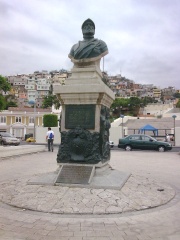
5. Francisco de Orellana (1511 - 1546)
With an HPI of 73.93, Francisco de Orellana is the 5th most famous Spanish Explorer. His biography has been translated into 50 different languages.
Francisco de Orellana (Spanish pronunciation: [fɾanˈθisko ðe oɾeˈʎana]; 1511 – November 1546) was a Spanish explorer and conquistador. In one of the most improbably successful voyages in known history, Orellana managed to sail the length of the Amazon, arriving at the river's mouth on 24 August 1542. He and his party sailed along the Atlantic coast until reaching Cubagua Island, near the coast of Venezuela. Orellana founded the city of Guayaquil in what is now Ecuador, and died during a second expedition on the Amazon.

6. Francisco Vázquez de Coronado (1510 - 1554)
With an HPI of 73.72, Francisco Vázquez de Coronado is the 6th most famous Spanish Explorer. His biography has been translated into 41 different languages.
Francisco Vázquez de Coronado (Spanish pronunciation: [fɾanˈθisko ˈβaθkeθ ðe koɾoˈnaðo]; 1510 – 22 September 1554) was a Spanish conquistador and explorer who led a large expedition from what is now Mexico to present-day Kansas through what is now parts of the southwestern United States between 1540 and 1542. Vázquez de Coronado had hoped to reach the Cities of Cíbola, often referred to now as the mythical Seven Cities of Gold. His expedition marked the first European sightings of the Grand Canyon and the Colorado River, among other landmarks. His name is often Anglicized as Vasquez de Coronado or just Coronado.

7. Juan Ponce de León (1460 - 1521)
With an HPI of 73.64, Juan Ponce de León is the 7th most famous Spanish Explorer. His biography has been translated into 61 different languages.
Juan Ponce de León (c. 1474 – July 1521) was a Spanish explorer and conquistador known for leading the first official European expedition to Puerto Rico in 1508 and Florida in 1513. He was born in Santervás de Campos, Valladolid, Spain, in 1474. Though little is known about his family, he was of noble birth and served in the Spanish military from a young age. He first came to the Americas as a "gentleman volunteer" with Christopher Columbus's second expedition in 1493. By the early 1500s, Ponce de León was a top military official in the colonial government of Hispaniola, where he helped crush a rebellion of the native Taíno people. He was authorized to explore the neighbouring island of Puerto Rico in 1508 and to take office as the first Governor of Puerto Rico by appointment of the Spanish crown in 1509. While Ponce de León grew quite wealthy from his plantations and mines, he faced an ongoing legal conflict with Diego Colón, the late Christopher Columbus's son, over the right to govern Puerto Rico. After a long court battle, Colón replaced Ponce de León as governor in 1511. Ponce de León decided to follow the advice of the sympathetic King Ferdinand and explore more of the Caribbean Sea. In 1513, Ponce de León led the first known European expedition to La Florida, which he named during his first voyage to the area. He landed somewhere along Florida's east coast, then charted the Atlantic coast down to the Florida Keys and north along the Gulf coast. Though in popular culture he was supposedly searching for the Fountain of Youth, there is no contemporary evidence to support the story, which most modern historians consider a myth. Ponce de León returned to Spain in 1514 and was knighted by King Ferdinand, who also reinstated him as the governor of Puerto Rico and authorized him to settle Florida. He returned to the Caribbean in 1515, but plans to organize an expedition to Florida were delayed by the death of King Ferdinand in 1516, after which Ponce de León again travelled to Spain to defend his grants and titles. He did not return to Puerto Rico for two years. In March 1521, Ponce de León finally returned to Southwest Florida with the first large-scale attempt to establish a Spanish colony in what is now the continental United States. However, the native Calusa people fiercely resisted the incursion, and Ponce de Léon was seriously wounded in a skirmish. The colonization attempt was abandoned, and he died from his wounds soon after returning to Cuba in early July. He was interred in Puerto Rico; his tomb is located inside the Cathedral of San Juan Bautista in San Juan.

8. Diego de Almagro (1475 - 1538)
With an HPI of 72.51, Diego de Almagro is the 8th most famous Spanish Explorer. His biography has been translated into 46 different languages.
Diego de Almagro (Spanish: [ˈdjeɣo ðe alˈmaɣɾo]; c. 1475 – July 8, 1538), also known as El Adelantado and El Viejo, was a Spanish conquistador known for his exploits in western South America. He participated with Francisco Pizarro in the Spanish conquest of Peru. While subduing the Inca Empire he laid the foundation for Quito and Trujillo as Spanish cities in present-day Ecuador and Peru, respectively. From Peru, Almagro led the first Spanish military expedition to central Chile. Back in Peru, a longstanding conflict with Pizarro over the control of the former Inca capital of Cuzco erupted into a civil war between the two bands of conquistadores. In the battle of Las Salinas in 1538, Almagro was defeated by the Pizarro brothers and months later he was executed.

9. Hernando de Soto (1500 - 1542)
With an HPI of 71.13, Hernando de Soto is the 9th most famous Spanish Explorer. His biography has been translated into 67 different languages.
Hernando de Soto (; Spanish: [eɾˈnando ðe ˈsoto]; c. 1497 – 21 May 1542) was a Spanish explorer and conquistador who was involved in expeditions in Nicaragua and the Yucatan Peninsula. He played an important role in Francisco Pizarro's conquest of the Inca Empire in Peru, but is best known for leading the first European expedition deep into the territory of the modern-day United States (through Florida, Georgia, Tennessee, Alabama, North Carolina, South Carolina, Mississippi, and most likely Arkansas). He is the first European documented as having crossed the Mississippi River. De Soto's North American expedition was a vast undertaking. It ranged throughout what is now the southeastern United States, searching both for gold, which had been reported by various Native American tribes and earlier coastal explorers, and for a passage to China or the Pacific coast. De Soto died in 1542 on the banks of the Mississippi River; sources disagree on the exact location, whether it was what is now Lake Village, Arkansas, or Ferriday, Louisiana. Although the scribe (Garcilaso) and the translator (Hakluyt) took different approaches regarding the presentation of de Soto's voyage, both intellectuals took unofficial accounts and instilled them with authority for the benefit of their respective empires. Their writings created overlapping yet distinct portrayals of de Soto’s expedition, shaped by each author’s cultural and political context.
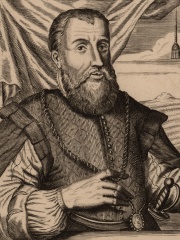
10. Diego Velázquez de Cuéllar (1465 - 1524)
With an HPI of 70.37, Diego Velázquez de Cuéllar is the 10th most famous Spanish Explorer. His biography has been translated into 40 different languages.
Diego Velázquez de Cuéllar (1465 – c. June 12, 1524) was a Spanish conquistador and adelantado who was first governor of Cuba. In 1511 he led the successful conquest and colonization of Cuba. As the first governor of the island, he established several municipalities that remain important to this day and positioned Cuba as a center of trade and a staging point for expeditions of conquest elsewhere. From Cuba, he chartered important expeditions that led to the Spanish discovery and conquest of the Aztec Empire.
People
Pantheon has 55 people classified as Spanish explorers born between 1130 and 1742. Of these 55, none of them are still alive today. The most famous deceased Spanish explorers include Hernán Cortés, Francisco Pizarro, and Juan Sebastián Elcano.
Deceased Spanish Explorers
Go to all RankingsHernán Cortés
1485 - 1547
HPI: 85.59
Francisco Pizarro
1478 - 1541
HPI: 82.05
Juan Sebastián Elcano
1476 - 1526
HPI: 77.91
Vasco Núñez de Balboa
1475 - 1519
HPI: 75.02
Francisco de Orellana
1511 - 1546
HPI: 73.93
Francisco Vázquez de Coronado
1510 - 1554
HPI: 73.72
Juan Ponce de León
1460 - 1521
HPI: 73.64
Diego de Almagro
1475 - 1538
HPI: 72.51
Hernando de Soto
1500 - 1542
HPI: 71.13
Diego Velázquez de Cuéllar
1465 - 1524
HPI: 70.37
Alonso de Ojeda
1466 - 1515
HPI: 69.94
Juan Díaz de Solís
1470 - 1516
HPI: 69.38

